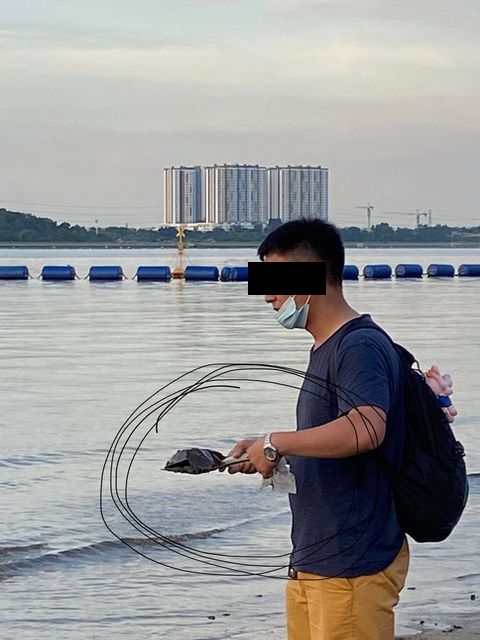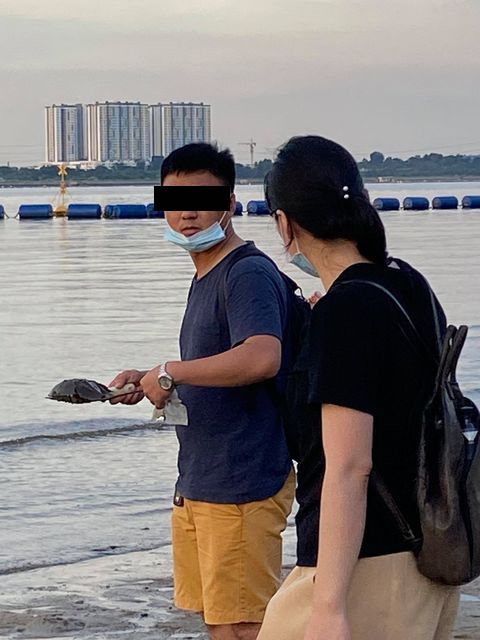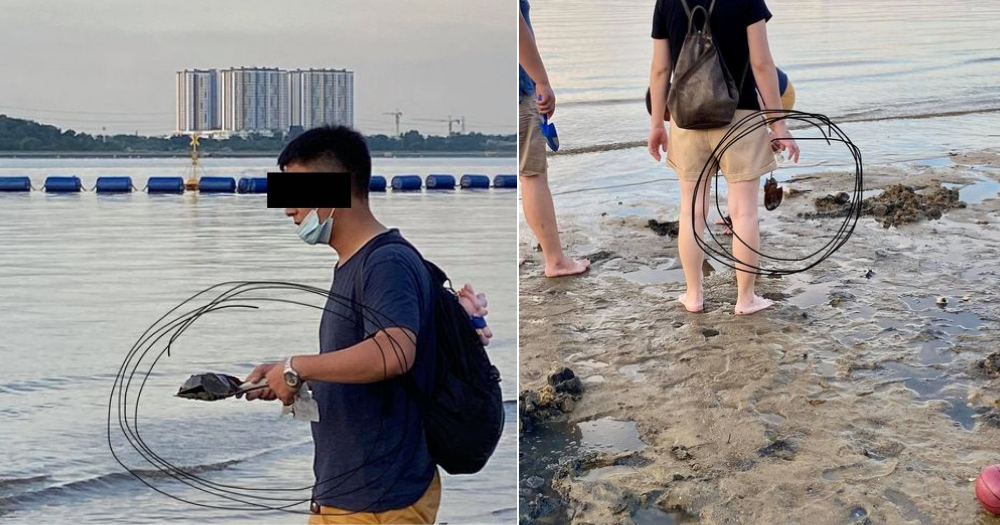The remaining natural habitats that are home to a diverse group of wild animals in urbanised Singapore are regarded as highly precious.
This was why a recent incident involving groups of people indiscriminately catching sea creatures at the Changi intertidal area sparked public outrage and concern.
And it appears there is a repeat incident of what happened at Changi at another coastal area in Singapore.
Over the weekend, a group of more than five adults and children were sighted catching sea creatures at the Sembawang Park coastal area.
Endangered horseshoe crab and other sea creatures caught
According to a tip-off by a Mothership reader, who wants to remain anonymous, the group was sighted at the coastal area on June 27 at around 6:40pm.
They had with them a Styrofoam box, small shovels, tongs and fishing nets, Mothership understands.
A man and a woman were even photographed holding onto the telson of a horseshoe crab, an endangered marine creature in Singapore.
 via Mothership reader.
via Mothership reader.
 via Mothership reader.
via Mothership reader.
 via Mothership reader.
via Mothership reader.
The reader said that based on what she heard from their conversation, the group appeared to have been aware that horseshoe crabs are endangered.
However, the reader said she was afraid to confront the large group alone.
"[I] understand that due to Covid-19, people are coming out to explore Singapore, but catching an endangered animal is totally unacceptable," the reader told Mothership.
"They even had a Styrofoam box to keep other sea creatures like small crabs and were saying [they] wanted to cook for tonight's dinner," she added.
The informant was also concerned about the way sea creatures were handled.
She observed that there were "a lot of dead baby flower crabs", which she believes were thrown away after they were removed from the water for too long.
"I hope this will catch the attention of NParks and they can arrange someone to patrol the beach, especially on weekends," she said.
NParks staff and volunteers conduct public outreach
Practising good wildlife etiquette is important to ensure future generations can continue to enjoy the presence of nature sites and wildlife.
Over the weekend, volunteers and staff of National Parks Board (NParks) were deployed during low-tide hours to various intertidal coastal areas to raise awareness of good wildlife etiquette, including the coastal site at Sembawang Park.
Minister for National Development Desmond Lee also joined the volunteers and staff at Changi Beach on June 27 morning.
Earlier this month, NParks had also said it will step up patrols at intertidal areas and put up more signs to educate members of the public on how to treat sea creatures and their environment.Not all invertebrates are and can be protected under the Wildlife Act in Singapore, as invertebrates refer to a broad range of cold-blooded animals without backbones, including cockroaches, centipedes, and sea anemones.
Horseshoe crabs not protected under the Wildlife Act
Currently, eight types of invertebrates and three types of fish are protected under the Wildlife Act.
Horseshoe crabs are not included as one of the protected wildlife species though.
This means that catching horseshoe crabs has not been made illegal in Singapore yet.
Unlike nature reserves and parks, intertidal zones, which only appear during low tides, are not under NParks' purview.
Horseshoe crabs in Singapore
Globally, there are four species of horseshoe crabs, and two of these species can be found in Singapore — the mangrove horseshoe crab (Carcinoscorpius rotundicauda) and the coastal horseshoe crab (Tachypleus gigas).
According to the Singapore Red Data Book, the mangrove horseshoe crab is listed as "Vulnerable" while the coastal horseshoe crab is listed as "Endangered".
A six-month survey, the Horseshoe Crab Project, was initiated in 2013 to determine the population of horseshoe crabs in Singapore so as to improve the conservation effort of these living fossils.
Horseshoe crabs are known as living fossils as they have existed since 400 million years ago and have undergone little morphological evolution for the past 200 million years.
While they are called horseshoe crabs, they are not real crabs but more closely related to spiders and scorpions.
Horseshoe crabs are part of the ecosystem, serving as an important food source for shorebirds that feed on their eggs.
In Singapore, the number of horseshoe crabs have declined due to loss of habitats.
Land reclamation has altered the coastal areas over the years and the mangrove cover in Singapore has decreased drastically due to urbanisation.
Abandoned fishing nets are also another source of threat to the horseshoe crabs in Singapore.
Top images by Mothership reader
If you like what you read, follow us on Facebook, Instagram, Twitter and Telegram to get the latest updates.
